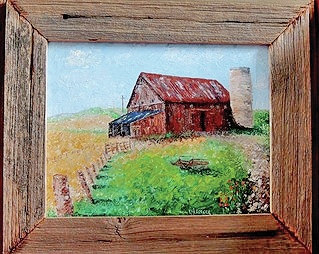
Editor’s Note: This is the fifth in a new series of stories authored by Robert Kroeger, who has painted 23 barns in Highland County. The most recent 12 paintings, usually framed with actual wood from the barn depicted, will be auctioned off Sept. 24 when the Highland County Historical Society holds its annual Log Cabin Cookout. Proceeds from the paintings will benefit the historical society. Kroeger titled this story “Six Foot Two.”
Everett Snyder owns this barn and teaches special education in the Fairfield Local School District. He runs the 12-acre farm on the side and keeps busy raising sheep and chickens. He told me he bought some llamas to scare away coyotes, those rascals that love to feast on chickens. You couldn’t miss that young white llama prancing around the fields, a recent offspring.
He told me that the nearby farmhouse, built in 1868, was owned by the Johnsons. Was the farm a grant to an Ohio soldier in the Civil War? Lydia Johnson is buried there, her grave marked by a stone slab marked 1919. She married a Barrett, whose family owned the farm for decades. When Snyder bought it in 1990, he had to deal with the back of the barn collapsing. He not only repaired that, but did extensive remodeling. Judging from the inside, many timbers have been replaced, fortifying this barn enough to last another century or two, which means all those squawking chickens have security.
In the center of the yard below the barn entrance sits an antique manure spreader, which I chose to include in the painting. There’s a website, antiquefarmequipment.com, that lists ads for those selling these old manure spreaders – ranging in price from $500 to thousands of dollars. Ebay, of course, has several for sale. One seller called his “my little dependable” and said he reluctantly was parting with it since he didn’t spread anymore. Another spreader, a Kemp Worcester listed at $5,500, was in pretty good shape, and had metal, not rubber, wheels. I’d call the seller an optimist, although this spreader is named after the first inventor, Joseph Kemp, and probably commands top dollar as an original.
In 1875 Kemp, a Canadian, introduced the first manure spreaders, pulled by a horse or team of horses, using a rotating device to sling the manure into the field. Shortly afterward, he moved to the USA and set up manufacturing units in New York and Iowa. In 1906, he sold his company to International Harvester.
Sitting on top of a natural rise, this old barn has seen a lot in its days, including a time when horses pulled that manure spreader through the fields. If the barn could talk, I’m sure he could tell a lot of stories: he’s seen generations of families tracing back to the 1800s, hundreds of farm animals, parched summers and cold winters and, more than likely, one or two basketball players standing six foot two.
Robert Kroeger is a former Cincinnati area dentist who has since ran in and organized marathons, took up the painting skills he first picked up from his commercial artist father, become a published author, and is a certified personal trainer that started the LifeNuts vitality program. Visit his website at http://barnart.weebly.com/paintings.html.


